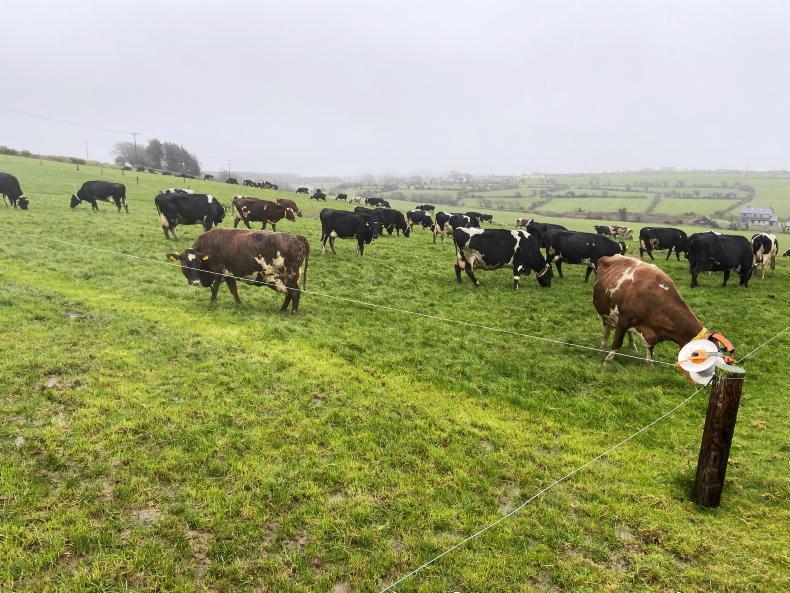Growth rates this week were well again above the 10-year average for this time of the year. This has led to higher covers than expected on farms across the country.
Although this is not necessarily a bad thing, a change in the weather over the last 10 days has made achieving target graze-out on heavy covers more difficult.
At this stage, every farm should be now on their last rotation. Each paddock grazed should be closed to ensure there is enough grass available for spring grazing.
Achieving good graze-outs on the last rotation will avoid carrying dead material over the winter and ensure good-quality grass is available in the spring.
While setting the farm up for spring grazing on the last rotation, it is very important to have grass in the correct paddocks for next spring.

One of the herds grazing a grass and clover sward in heavy rain.
With this in mind, it is important to remember that the target pre-grazing covers on the first paddocks to be grazed in the spring is between 800kg and 1,000kg DM/ha.
Grazing these lighter than normal covers allows cows to transition on to a grass-based diet while not wasting too much grass in the process.
Advantage
The other advantage of this is that small groups of cows let out in spring will get more ground grazed in a shorter time.
This will help get growth kickstarted and ensure grass is available for the second round.
Paddocks grazed now will have the heaviest covers in the spring time.
For this reason, these paddocks should be dry and have good access. These paddocks will be grazed in the first two weeks of March next year.
Target to graze paddocks that are dry, have multiple access points, are close to the parlour and can be divided easily between 15 and 25 October. These paddocks will be the first paddocks grazed next spring.
Target to graze wet paddocks, paddocks furthest from the parlour and paddocks with poor access as late as possible in the autumn.
These will have the lowest covers in the spring and won’t be grazed until the end of March next year.
Growth rates this week were well again above the 10-year average for this time of the year. This has led to higher covers than expected on farms across the country.
Although this is not necessarily a bad thing, a change in the weather over the last 10 days has made achieving target graze-out on heavy covers more difficult.
At this stage, every farm should be now on their last rotation. Each paddock grazed should be closed to ensure there is enough grass available for spring grazing.
Achieving good graze-outs on the last rotation will avoid carrying dead material over the winter and ensure good-quality grass is available in the spring.
While setting the farm up for spring grazing on the last rotation, it is very important to have grass in the correct paddocks for next spring.

One of the herds grazing a grass and clover sward in heavy rain.
With this in mind, it is important to remember that the target pre-grazing covers on the first paddocks to be grazed in the spring is between 800kg and 1,000kg DM/ha.
Grazing these lighter than normal covers allows cows to transition on to a grass-based diet while not wasting too much grass in the process.
Advantage
The other advantage of this is that small groups of cows let out in spring will get more ground grazed in a shorter time.
This will help get growth kickstarted and ensure grass is available for the second round.
Paddocks grazed now will have the heaviest covers in the spring time.
For this reason, these paddocks should be dry and have good access. These paddocks will be grazed in the first two weeks of March next year.
Target to graze paddocks that are dry, have multiple access points, are close to the parlour and can be divided easily between 15 and 25 October. These paddocks will be the first paddocks grazed next spring.
Target to graze wet paddocks, paddocks furthest from the parlour and paddocks with poor access as late as possible in the autumn.
These will have the lowest covers in the spring and won’t be grazed until the end of March next year.







 This is a subscriber-only article
This is a subscriber-only article











SHARING OPTIONS: